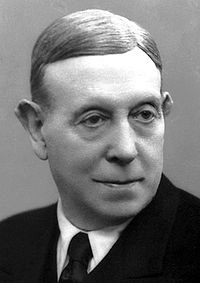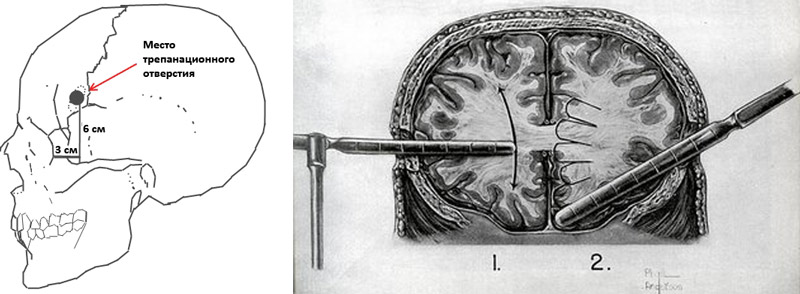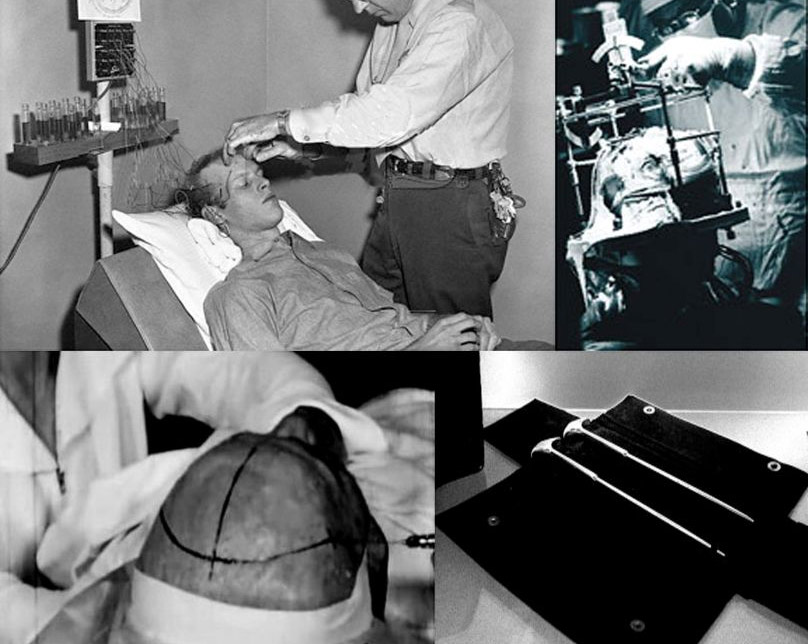Lobotomy is an out-of-practice and now prohibited psychosurgical intervention, in which one of the lobes of the brain was destroyed or the relationship between it and other parts of the central nervous system was disrupted. In some cases, the frontal lobes were removed. The purpose of the operation was defined as the fight against mental disorders in which no known conservative method is effective.
In the history of medicine, there are enough facts of the use of a variety of contradictory, scientifically unfounded and even barbaric methods that were proposed with a good purpose - to cure or alleviate suffering. And if many of them were practiced in antiquity or the Middle Ages out of ignorance, lack of technical and scientific capabilities of healers, then lobotomy is an example of inhumanity that has become very popular in the recent past.
Lobotomy surgery was extremely common in the United States and many countries of Western Europe. In the USSR, the method was also tested, but we must pay tribute to domestic specialists, who quickly raised the question of the feasibility, effectiveness, scientific validity of the mutilation operation and prohibited its implementation. Many sources explain this fact by the peculiarities of the policy and difficult relations of the Soviet Union with America and the Western countries, however, there is professionalism, caution, and humanity of Soviet doctors.
The term "lobotomy" meant either the removal of some lobes of the brain, more often the frontal, or the dissection of the neural pathways in order to reduce the influence of the frontal lobe on the rest of the brain. It is worth noting that the operation was proposed when there were no sufficiently informative methods for studying the nervous system in the arsenal of specialists in the field of psychiatry and neurophysiology, and the operations were often carried out not by surgeons at all.

Leukotomy is another name for the operation, which means the intersection of the nerve pathways that lie in the white matter of the brain. This manipulation leads not only to severe neurological symptoms, but also to the patient's loss of control over himself and over the intellect, which is reduced, at best, to the level of a young child. After a leukotomy, a person remains deeply disabled for life, unable to independently exist, think, communicate even with loved ones.
It should also be noted that clear indications have not been identified for lobotomy. That is, initially it was defined as a remedy for hopeless patients, but in view of the fact that it led to an improvement in the controllability of a person, like pets, it began to be practiced under other, unseemly pretexts, and was often carried out even by those who did not need the help of a psychiatrist at all.
The worst thing in the history of lobotomy is that the method spread very quickly and very widely and was popularized not by anyone, but by doctors, who, in theory, should save people, not cripple them. It is interesting that ardent admirers of the method, who managed to carry out thousands of lobotomies in a short time, not only did not repent, but did not realize the scale of the tragedy called “lobotomy” for both patients and their loved ones. Today, lobotomy is not done to anyone, whatever the symptoms of a mental disorder.
Good intentions with tragic consequences
So where did the lobotomy come from and why did it become so popular so quickly? The answer lies in historical facts and coincidences, the human qualities of individual doctors, the degree of defenselessness of patients in psychiatric clinics, and even the nuances of politics and economics in some countries.

The pioneer of lobotomy as a method of treatment in psychiatry is the Portuguese Egash Moniz, who was the first to use the technique in humans. Previous research was limited to lobotomy in chimpanzees, but Egash went further, which he himself did not regret, which cannot be said about the relatives of his patients.
The development of the brain lobotomy dates back to 1935, when Moniz suggested that uncoupling the nerve pathways of the frontal lobe of the brain could be effective in a number of psychiatric diseases. Without doing enough research and not weighing the risks, the psychiatrist decided to intervene the very next year. Since gout prevented him from doing it on his own, he entrusted the experiment, which he personally supervised, to the neurosurgeon Almeida Lima.
During the operation, the pathways of the white matter of the frontal lobes were separated, connecting these parts with other structures of the brain, but the lobes themselves were not destroyed, hence the name "leukotomy". Manipulation has been announced as a life-saving radical approach for hopeless patients.
The operation, which was proposed by E. Monish, was carried out as follows: with the help of a special conductor, a metal loop was introduced into the substance of the brain, which had to be rotated to destroy the nervous tissue. There was no talk of any more or less adequate anesthesia.

Under the leadership of Monish, about a hundred lobotomies were performed, and history is silent about the specifics of patient selection, determination of indications, and methods of previous treatment. Assessing the postoperative state of patients, Monish was quite subjective, and the observation itself was limited to several days, after which the patients fell out of the doctor's field of vision and no one was particularly worried about their fate.
Having defined lobotomy as an effective method of treatment, Moniz immediately began to propagate it among his colleagues, reporting the meager results of observations, limited to two dozen operated, but presented as reliable evidence of the effectiveness of the new technique. What motivated the doctor and why such a rush is not entirely clear. Maybe it was really a delusion out of good intentions, or maybe it was a desire to become famous and go down in history. One way or another, the name of Monish is known in narrow circles and has gone down in history.
According to the data published by Moniz, seven out of 20 operated patients recovered, the same number showed improvement, and six remained without positive dynamics. The adverse consequences that inevitably awaited all patients were kept silent. Actually, the psychiatrist himself did not seek to find out about them, releasing patients on all four sides a few days after the operation.
Today such a small number of observations seems to be something unreal, not capable of providing at least some basis for conclusions, but in the last century, scientists sharply criticized the data of E. Moniz. Nevertheless, the latter has published many publications and even books on leucotomy.

before and after examples of successful lobotomies
The further history of brain lobotomy unfolded tragically quickly, the operation became extremely popular, and the number of victims from it is estimated in tens of thousands in America alone.
Opponents of the method pointed out that the consequences of the operation are akin to those that occur with traumatic brain injury, focusing on personality degradation. Calling to abandon lobotomy, they explained that irreparable harm to any organ is not able to make it healthier, and even more so when it comes to such a complex and poorly studied structure like the human brain. In addition to the risk of neurological and mental impairment, lobotomy was considered dangerous due to the likelihood of meningitis and brain abscess.
The efforts of opponents of lobotomy were in vain: the operation was adopted as an experimental method of treatment by specialists not only from the USA and South America, but also by psychiatrists in Italy and other European countries. By the way, the indications for her were never formulated, and the experiment was literally put on stream, and not a single practicing doctor was responsible for its result.
In 1949, Egash Moniz was awarded the Nobel Prize for developing lobotomy as a treatment for psychiatric pathology. Somewhat later, the relatives of those patients who had undergone barbaric treatment asked to cancel this decision, but all their requests were rejected.
The peak of the use of lobotomy occurs in the early forties of the twentieth century, when it became very popular in the United States. One of the reasons is quite trivial: the high costs of maintaining patients and staff of psychiatric wards, which became overcrowded against the background of World War II by former soldiers who survived severe stress and could not cope with it on their own. Such patients often turned out to be aggressive or too agitated, it was rather difficult to control them, there were no special drugs, and the clinics had to maintain a large staff of orderlies and nurses.
Lobotomy was a cheap and relatively simple way to deal with aggressive and uncontrollable patients, so the authorities even organized special training programs for surgeons. It is estimated that using the operation would reduce costs by $ 1 million daily. In addition, there were no effective methods of conservative therapy for mental illness at that time, so lobotomy quickly gained popularity.
Dr. Freeman and the ice pick
Meanwhile, the war ended, and the number of newly admitted former military personnel in psychiatry was decreasing. It would seem that there was no longer such a need for a lobotomy. However, the operations were not only not suspended. According to some reports, their popularity only began to grow, and surgeons were already able to demonstrate new tools and methods for destroying nervous tissue, not at all embarrassed if a child turned out to be a patient.
In many ways, the widespread use of lobotomy after 1945 was due to the American psychiatrist Walter Freeman, who proposed the so-called transorbital lobotomy. Its difference from the previously used techniques is in the access lying through the eye socket. Freeman actively promoted leucotomy and conducted more than one thousand such operations himself.

By the way, not only lobotomy looks barbaric, but also methods of pain relief. In a number of cases, they were absent altogether, and the same Freeman, during his first operation, provided analgesia to the poor fellow-patient with an electroconvulsive effect. After strong electrical discharges, the patient loses consciousness for a short time, but it is enough to carry out a lobotomy.
Freeman's technique consisted of inserting a sharp instrument, resembling an ice pick, into the eye socket and then into the brain. Wielding a hammer and such a knife, Freeman fell through the puncture of the bone directly to the brain, in which he cut the nerve fibers. According to the doctor, such treatment was supposed to save a patient suffering from a mental illness from aggression, strong emotionality and uncontrollability.
There is information according to which it was the ice pick knife that became the tool that seemed most suitable for transorbital lobotomy. According to Freeman's relatives, during one of the operations, which, by the way, was not always carried out not only in the operating room, but in the clinic in general, a surgical instrument broke. The action took place at home, and the surgeon had an ice knife at hand, which he hastened to send to the patient's brain. The knife seemed convenient, and thus Freeman, having slightly modified it and provided it with divisions with the designation of the length, became the inventor of the leukotome and orbitoclast.

Freeman lobotomy technique
Recall that the operation was done blindly, that is, neither before nor after did no one conduct any brain studies, and in those years they did not know about MRI at all. The surgeon or psychiatrist destroyed the areas of the brain that came across in the path of the cutting tool, without worrying in the least about the extent of damage that could be caused.
In fairness, it should be noted that the first results of lobotomies were indeed positive, because aggressive patients almost immediately became calm and even indifferent to what was happening. Nevertheless, this does not justify the operation itself, since it was carried out in completely different ways for patients with different diagnoses.
In addition, there was no clear system for analyzing the results, and the factor of controllability of the operated after the intervention was used as a cure criterion. The "calmed down" mentally ill left the clinic and no one was interested in their further state of health and fate.
but on the other hand
Almost a decade after the beginning of the experimental use of lobotomies, more scrupulous studies of its feasibility and even danger began. So, it turned out that mortality after surgery reaches 6%, and among the side effects are convulsive syndrome in a third of patients, obesity, impaired motor function up to paralysis, disorders of the function of the pelvic organs, speech and much more.

But the influence of lobotomy on personality, intelligence and human behavior was much more dire consequences. In almost all of the operated patients, the intellect decreased to the level of infancy, control over behavior and actions was lost, emotional lability, indifference, lack of initiative and the ability for purposeful, meaningful actions were observed. Lost criticism to oneself about the world around, the ability to make plans, work and live more or less fully in society.
By the way, Freeman himself did not regard such personality changes, which practically ceased to exist, as a negative result of treatment. According to his observations, a quarter of those operated on regressed intellectually to the level of a pet, but became controllable and quiet.
Longer observations have shown that 10-15 years after lobotomy, the connection between the frontal lobes and other brain structures is partially restored, returning hallucinations to mentally ill people, and delusional disorders, and aggression, but not intelligence. Reoperations further exacerbated the intellectual and personality changes.
A few terrifying facts about lobotomy
The scale of the ongoing lobotomies campaign is impressive: by the middle of the last century, up to 5,000 of them were performed annually in America alone. In total, during the period from the first experiment, about fifty thousand American patients were treated, and, moreover, not only severe schizophrenia, but also neuroses, anxiety disorders, and depression could become the reason for the operation.

Other truly strange circumstances for surgical treatment can be considered the conditions of the operation - in Dr. Freeman's special van, in the ward, and even at home. Without observing asepsis and antiseptics, with non-sterile instruments, in the presence of a large number of observers.
Lobotomies were widely practiced by psychiatrists who had a vague understanding of surgery, the features of operations on the brain and its anatomy. Dr. Freeman himself did not have a surgical education, but managed to perform about 3.5 thousand lobotomies.
There is also the abuse of lobotomy under plausible pretexts: they began to do it to ill-managed and hyperactive children, grumpy wives, emotionally unstable young women. By the way, there were much more men among the operated women.
Since the second half of the twentieth century, it was no longer possible to hide the most serious negative consequences of lobotomy. The operation was finally declared dangerous and was banned at the legislative level. Dozens and thousands of victims of the inhuman method of treatment, broken lives, as well as relatives who actually lost loved ones during their lifetime are confirmation of not a curative, but a crippling effect on the brain.
In the USSR, psychiatrists and neurosurgeons approached the issue of lobotomy rather carefully, not rushing to massively destroy the brain of Soviet people with a knife. The first to question the expediency of the method was the outstanding surgeon N.N. Burdenko, who instructed his doctoral student Yu. B. Rozinsky to thoroughly analyze the essence and prospects of lobotomy in severe psychiatric pathology.
However, there were also like-minded people of Freeman and Monish in the Soviet Union, in particular, Professor Shmaryan A.S, who actively promoted prefrontal lobotomy and even found a supporter of the method among neurosurgeons - not just someone, but an outstanding scientist-neurosurgeon, the future director of the Institute of Neurosurgery.
Professor Egorov, who performed lobotomies "at the suggestion" of Shmaryan, approached the issue of the operation technique more carefully, applying his own modification - osteoplastic trepanation for good revision and orientation at the site of destruction of the brain tissue. The "Soviet" version of leukotomy was much more sparing, since it involved only one-sided intersection of the nerve pathways while maintaining the integrity of the ventricular system, pyramidal tracts and basal ganglia.

Patients who were sent for a lobotomy were selected extremely harshly. The operation was considered expedient only when none of the known conservative methods, with long-term use, did not give positive dynamics, moreover, including insulin coma and the action of an electric current.
Before the operation, the patients were thoroughly examined by therapists, neurologists, and psychiatrists. After the lobotomy, the observation continued, and the doctors clearly recorded absolutely all changes in the psyche, social adaptation, and behavior of the operated patients. Both positive and negative consequences, including death, were objectively analyzed. Thus, Russian doctors were able to formulate the reasons and obstacles to prefrontal lobotomy.
By 1948, based on the accumulated data of observations of patients after lobotomies, the operation was recognized in principle as permissible, but only if it was carried out by a highly qualified neurosurgeon, in a hospital, in case of irreversible brain damage and the ineffectiveness of all possible methods of treatment.
At the same time, neurophysiology begins to develop, new approaches to neurosurgical techniques for lobotomy are substantiated, and new tools and approaches appear. The results appeared to be satisfactory: more than half of the patients with paranoid schizophrenia experienced improvement, and a fifth - the restoration of normal mental status, working capacity and intelligence.
Nevertheless, it was not possible to avoid the consequences in the form of "frontal" and intellectual disorders even with the most gentle approaches. Disputes between opponents and supporters of psychosurgery did not subside. And if in 1949 lobotomy was classified as a relatively safe and even effective intervention, then a year later, in 1950, it was banned at the government level.
The ban on lobotomy in the USSR was dictated, rather, by scientific ideas and the results of clinical trials, rather than political reasons. Severe neuropsychiatric changes in the postoperative period did not allow lobotomy to enter the list of officially approved operations.
Lobotomy was banned thanks to the efforts of Professor Gilyarovsky, who repeatedly raised a discussion of this problem among scientists. The tests initiated by him showed that the intervention is performed not only by surgeons, but also by psychiatrists, and all patients remain with organic disorders of brain activity expressed to varying degrees.
An end to the history of lobotomies in Russia was set by Gilyarovsky's devastating article in the journal Medical Worker, where the method of treatment itself and its justification by American psychiatrists were criticized, and then by the publication in Pravda, in which lobotomy was called a pseudoscientific method of bourgeois medicine. which has no place among Soviet doctors, brought up in the spirit of humanism. On December 9, 1950, lobotomy was officially banned in the USSR.
Fortunately, today lobotomy is a horrifying past, one of the most unsightly examples of scientific research that has turned into a tragedy for many thousands of patients and their families. I would like to believe that modern medicine will not come up with a new method of treatment, which will become such a large-scale experiment on humans, carried out with the support of the governments of quite developed countries.

